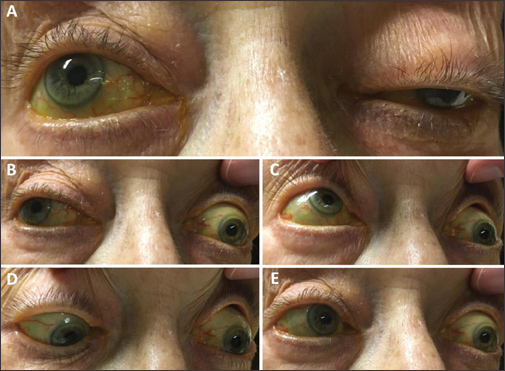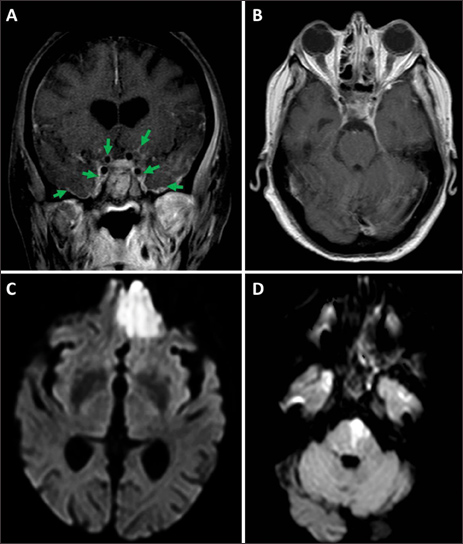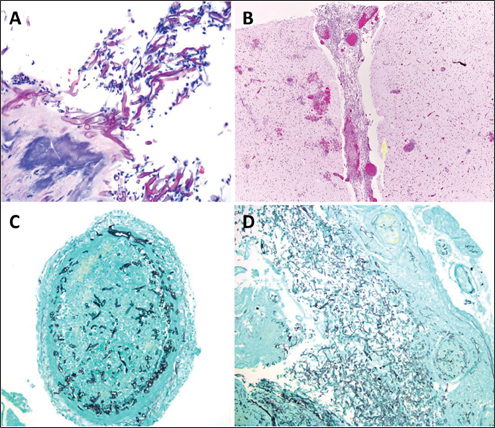Elderly woman presents with rapidly progressive bilateral ophthalmoplegia and blindness
Exam findings include no light perception vision, nonreactive pupils and left-sided ptosis.
An 80-year-old woman was transferred from an outside hospital to the emergency department at Tufts Medical Center for ophthalmological evaluation around midnight. In a matter of hours, she had developed bilateral, progressive ophthalmoplegia and complete vision loss. She endorsed worsening “swelling” of the left upper eyelid and numbness around the left eye and cheek for the past 2 days. She also reported a 1-week history of pain in the left forehead and temple, as though her jaw felt “locked.” Her primary care physician had recently discovered ethmoidal and sphenoidal sinus disease on a CT scan and started her on oral amoxicillin/clavulanic acid, which she was unable to take due to nausea and vomiting.
The patient had a history of chronic lymphocytic leukemia (CLL) diagnosed 25 years earlier, which was complicated by cold agglutinin disease, iron overload, hepatomegaly and cardiomegaly secondary to serial blood transfusions. She was unable to tolerate ibrutinib, a tyrosine kinase inhibitor prescribed for the treatment of CLL. She also had a history of right-sided heart failure, hypertension and anxiety/depression disorder. Her prescribed medications included deferiprone, hydrochlorothiazide, metoprolol, amitriptyline, diazepam, duloxetine, and the ibrutinib and amoxicillin/clavulanic acid that she was unable to tolerate. She had allergies to aspirin and lidocaine. She was a former smoker with a 10 pack-year history. She denied alcohol use. She lived alone with her cat and did all her activities of daily living independently without limitations.
She had undergone a head CT at the outside hospital that evening, which again showed sinus disease without significant intracranial abnormalities. Brain MRI was limited by motion artifact. She had been started on IV vancomycin and cefepime before she was transferred to our institution for further care.
Examination
On initial exam at our institution, vision was no light perception in both eyes. Pupils measured 4 mm in the right eye and 4.5 mm in the left eye; both were nonreactive to light. IOPs were within normal limits in both eyes. The patient had near complete ptosis of the left upper eyelid (Figure 1a), complete ophthalmoplegia of the left eye and diminished ductions in all directions of gaze of the right eye (Figures 1b to 1e). She had decreased sensation in the left trigeminal V2 distribution. The rest of the ocular examination was unremarkable, except for moderate bilateral nuclear sclerosis. The retinas appeared intact. The optic nerves showed no pallor or swelling. Her nose was noted to bleed during the exam, but no nasal or palatal eschars were seen.

Source: Melina I. Morkin, MD, and Thomas R. Hedges III, MD
What is your diagnosis?
See answer on the next page.
Rapid onset of symptoms
The rapid onset of symptoms and presence of complete loss of vision, nonreactive pupils and bilateral ophthalmoplegia warrant expeditious diagnosis and management.
Pituitary apoplexy should be suspected in patients presenting with sudden-onset headache behind the eyes or ears, somnolence, ophthalmoplegia and vision changes. MRI provides a 90% sensitivity in identifying pituitary apoplexy, demonstrating pituitary infarction and/or hemorrhage. Prompt treatment with IV hydrocortisone and surgical decompression should be considered.
Giant cell arteritis can present with severe vision loss with cranial nerve palsies and should be presumed in elderly patients with scalp tenderness, jaw claudication, unexplained weight loss, weakness, fever or shoulder/hip pain. High-dose IV steroids should be given, even if the diagnosis is not yet confirmed by biopsy, to minimize irreversible vision loss and further ischemic events.
The presence of ophthalmoplegia and ptosis can suggest a cavernous sinus syndrome, which can be caused by thrombosis in the setting of an infection, such as bacterial or fungal sinusitis, or hypercoagulable states, such as with CLL. Tolosa-Hunt syndrome is an idiopathic inflammatory condition that primarily affects the cavernous sinus, causing unilateral painful ophthalmoplegia that responds to steroids.
Bilateral cranial nerve involvement suggests a diffuse process, such as infiltrative malignancy (eg, leukemia/lymphoma, carcinoma, carcinomatous meningitis) or midline mass with bilateral extension (eg, brainstem tumors, aneurysm, nasopharyngeal carcinoma).
Workup and management
Our patient reported a “locked jaw” and pain around the temple, as well as malady. ESR was within normal limits, but CRP was 287.55 (normal range: 0.0 to 7.5). New brain MRI showed filling defects within the cavernous sinus and air-fluid levels within the paranasal sinuses. IV vancomycin and cefepime were continued, and neurology and ENT were consulted.

On her way to the inpatient floor in the early morning, the patient became suddenly somnolent, dysarthric and hemiparetic. She was transferred to the neurocritical care unit. A heparin drip was started. Despite multiple discussions with the patient and her family, she repeatedly refused a lumbar puncture. ENT performed a nasal endoscopy, which revealed purulent drainage in the right and left middle meatuses, but no necrosis. Gram stain of the discharge sample showed polymorphonuclear leukocytes and gram-positive cocci in chains.
In the afternoon, her neurologic status worsened. Repeat MRI showed new infarcts in the frontal and temporal lobes and left pons, along with leptomeningeal enhancement (Figure 2). She was intubated and started on systemic vasopressors. Given the patient’s rapid decline and poor prognosis, the family decided to transition her to comfort measures only. Less than 24 hours after presentation to Tufts, she was pronounced dead.
Bacterial culture of the discharge from the left middle meatus was positive for coagulase-negative Staphylococcus, while a 4-week follow-up of the fungal culture revealed no growth. Autopsy showed a thrombotic cavernous sinus, uncal edema and herniation, and global brain ischemia. Microscopic examination revealed mucormycosis with vascular and perineural invasion, and meningoencephalitis (Figure 3).
Discussion
Mucormycosis can be caused by different genera within the order of the Mucorales, most commonly Mucor, Rhizopus and Absidia. Through inhalation of airborne spores, the fungi gain access to the pterygopalatine fossa, the most common reservoir in humans. Mucormycosis typically infects the sinuses first and then can extend to the brain in three ways: erosion of the sinus walls; extension via vascular structures, which can lead to cavernous sinus thrombosis and brain infarction; or spread along neuronal tissue, resulting in nerve palsies, meningitis and encephalitis.

In terms of clinical presentation, affected patients can initially experience symptoms of acute sinusitis, fever, headache and sinus pain. As the infection progresses, necrotic tissue can be found on the palate or nasal cavities, along with possible destruction of the turbinates, perinasal swelling and skin discoloration. Ultimately, there can be orbital signs of infection, including decreased vision and cranial nerve palsies due to cavernous sinus thrombosis. Of note, the ischemic events seen with mucormycosis can occur in a characteristic stepwise fashion, such as in our case, due to the progressive vascular invasion by hyphae.
Predisposing factors include diabetes (seen in 70% of patients, particularly if ketoacidosis is present), immunosuppression due to systemic steroid treatment, hematologic malignancy, hematopoietic or organ transplantation, AIDS, IV drug use, iron overload, and treatment with deferoxamine, among others. Interestingly, both iron overload and deferoxamine, an iron-chelating agent, increase the iron uptake by the fungus, which enhances fungal growth and its pathogenicity.
Endoscopic evaluation should be performed as soon as the diagnosis is suspected to identify tissue necrosis and obtain specimens for microbiological studies. The organisms can be recognized with stains such as hematoxylin and eosin, calcofluor white, periodic acid-Schiff or Gomori methenamine silver. Broad, irregularly branched hyphae with rare septations, measuring 5 µm to 15 µm in diameter, are typical. In contrast, hyphae of ascomycetous molds (eg, Aspergillus) are narrower (2 µm to 5 µm in diameter), regularly branched with many septations.
The fungi can grow rapidly on most fungal cultures (ie, 3 to 5 days on Sabouraud or potato dextrose agar at 25°C to 30°C) but are positive in only one-third of the cases. Polymerase chain reaction (PCR) is especially useful in culture-negative cases. For example, in a study investigating the role of PCR in the diagnosis of mucormycosis, 10 out of 12 culture-positive patients tested positive for PCR, while 12 out of 15 culture-negative cases were also PCR-positive. Of note, fungal serum tests such as 1,3-beta-D-glucan and galactomannan are negative in mucormycosis because these fungi do not share the same cell wall components as in other invasive fungi.
Treatment of mucormycosis involves a combination of early aggressive surgical debridement and antifungal medications. Predisposing factors such as hyperglycemia, metabolic acidosis, deferoxamine use and neutropenia should be eliminated if possible. Although there are no randomized trials on the efficacy of different antifungal regimens given the rarity of the disease, amphotericin B is generally accepted as the first-line drug of choice. Posaconazole or isavuconazole can be given orally as a “step-down therapy” for those who have responded to amphotericin B or intravenously in patients who do not respond to or cannot tolerate amphotericin B.
The overall mortality from rhino-orbital-cerebral mucormycosis ranges from 25% to 62%. The mortality is lowest if the infection is limited to the sinuses and highest if there is brain, cavernous sinus or carotid involvement, all of which can be acutely fatal, especially in immunocompromised patients. Mortality from pulmonary mucormycosis, on the other hand, is as high as 87%. Factors associated with death, based on a review of 208 patients with rhino-orbital-cerebral mucormycosis, include late diagnosis, the presence of hemiparesis/hemiplegia, bilateral sinus disease, leukemia, renal impairment and deferoxamine use.
- References:
- Boelaert JR, et al. Am J Kidney Dis. 1991;doi:10.1016/S0272-6386(12)80606-8.
- de Rooij MF, et al. Blood. 2012;doi:10.1182/blood-2011-11-390989.
- Khatri IA, et al. J Neurol Sci. 2016;doi:10.1016/j.jns.2016.01.035.
- Kreiniz N, et al. Hematol Oncol. 2017;doi:10.1002/hon.2387.
- Millon L, et al. Clin Microbiol Infect. 2016;doi:10.1016/j.cmi.2015.12.006.
- Spellberg B, et al. J Antimicrob Chemother. 2012;doi:10.1093/jac/dkr375.
- Yohai RA, et al. Surv Ophthalmol. 1994;doi:10.1016/S0039-6257(05)80041-4.
- For more information:
- Melina I. Morkin, MD, and Thomas R. Hedges III, MD, can be reached at New England Eye Center, Tufts University School of Medicine, 750 Washington St., Box 450, Boston, MA 02111; website: www.neec.com.
- Edited by Aubrey R. Tirpack, MD, and Astrid C. Werner, MD. They can be reached at the New England Eye Center, Tufts University School of Medicine, 750 Washington St., Box 450, Boston, MA 02111; website: www.neec.com.
